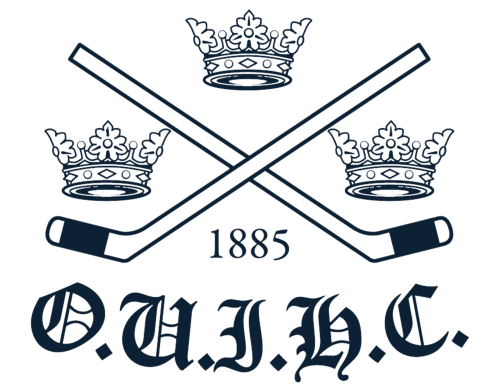
The Oxford University versus Cambridge University annual Varsity Match is the oldest hockey rivalry with the first match taking place in 1885 in St Moritz, Switzerland. Subsequent Varsity Matches were 1895 at Blenheim Palace in Oxford and in 1900 at the Prince’s Club in London. Nowadays, the OUIHC is a student-run inclusive community of academic ice hockey players from the University of Oxford and nearby institutions and the Varsity Match is played annually between the Oxford and Cambridge clubs over a weekend in March.
In 1921, the OUIHC was formed as an official University club – uniting all ice hockey players at Oxford. As in 1921, the values of inclusion and unity are still upheld by the OUIHC today as the club accommodates for players of all abilities. In addition, the Club honours the tradition of earning Oxford Blues in the Ice Hockey Varsity Match as all ‘Blues sports’ of the University may do. Consequently, the top Oxford ice hockey teams are known as Blues teams: the Men’s Blues and the Women’s Blues. The club has a second men’s team, the Oxford Vikings (formerly the Oxford Cosmopolitans), and a mixed development team called the Oxford Vikings B (or ‘Bikings’). The OUIHC welcomes all ice hockey players in Oxford who are studying or working in higher education.
Above: Ice hockey on Christ Church Meadow, February 1895. Source: pictureoxon.com
Below: The Oxford Men’s Blues and Oxford Vikings with OUIHC alumni at the 100th Varsity Match in St Moritz Switzerland, 133 years after the original 1885 match.
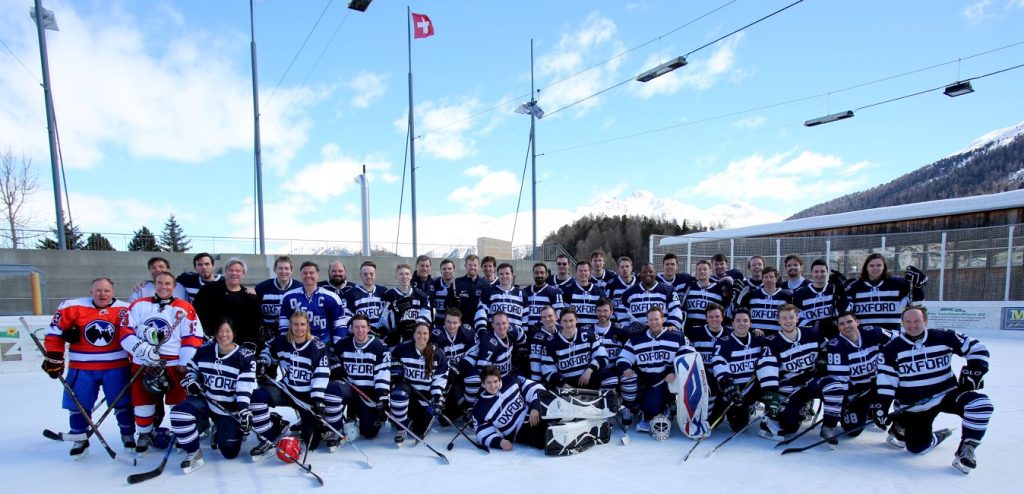

The Varsity Match in St. Moritz, Switzerland, c.1922. Scoreboard in background (4-2 to Oxford). Lester B. Pearson on the far right.
Hockey’s Oldest Rivalry
Recognised by the International Ice Hockey Federation (IIHF), the oldest hockey rivalry is the Oxford-Cambridge Varsity Match with the inaugural game taking place on the lake at St Moritz Switzerland in 1885. A subsequent Varsity Match was held in 1895 at Blenheim Palace and again on March 16th 1900 at the Prince’s Skating Club of London. It should be noted that the term ‘ice hockey’ is a relatively recent term, while the sport in the early days was likely a hybrid between bandy and modern day ice hockey, reported in the press as ‘hockey-on-the-ice’. The sport was developed, in part, through the OUIHC tours of Europe in the early nineteenth century. The 1900 match was initiated by Cambridge’s J. J. Cawthra – a Canadian student – who is considered to be the (re)founder of the ice hockey Varsity Match. The match was played with bandy sticks and a lacrosse ball, and although the game ended in a 7-6 victory for Oxford, Cawthra was the standout player on the ice.
After a repeat fixture in 1901 (6-5 to Cambridge), the Inter-Varsity Match and ice hockey began to fizzle out, and the 1902 match was played according to the rules of bandy which ended in an indecisive 2-2 tie. The Ice Hockey Varsity Match returned in 1909, this time, played in Wengen, Switzerland. The following year the Varsity Match moved to Mürren where the fixture would continue to be played until interrupted by World War I. Due to the outbreak of war ice hockey did not resume at the University until 1920 with the formation of a new University team by Kenneth Taylor, a Rhodes Scholar from Ontario, Canada.
Right: The 1910 Oxford and Cambridge university ice hockey teams Both teams are using a combination of bandy and hockey sticks.


Of note, in 1906, a group of Rhodes Scholars from Canada and the Dominion of Newfoundland formed a hockey team called the Oxford Canadians (among them, Major Talbot Mercer Papineau). While this team was not affiliated with the Oxford University team and did not play Cambridge, the Canadians drew media attention in both Britain and Canada. In 1908, the Montréal Gazette attributed an Oxford Canadians loss to their inability to “accustom themselves to the forward passing allowed” in Britain, as they were accustomed to rules which forbade this. The Oxford Canadians also toured Europe drawing further attention to their unique style of play. In the 1910 European Ice Hockey Championship in Les Avants, Switzerland, the Canadians were a last minute replacement for the French national team, to participate without competing for prize or title. The Times of London reported that “[t]he chief objective in admitting them” to the competition “was to give spectators an opportunity of observing their method and style of play.” The team folded following WWI, though a team called the Oxford Canadians has occasionally toured Europe since 2012, but is not associated with the Oxford University Ice Hockey Club.
The 1920 revival led to the formation of the Oxford University Ice Hockey Club (OUIHC) the following year. Under the OUIHC banner, the renewed team won an outstanding 1921 Varsity result which still stands as one of the largest Oxford victories: 27-0 (the largest is 29-0 in 1955).
The OUIHC remained a powerhouse throughout the 1920s and 30s, winning the majority of the Varsity Matches. In the 1920s, the team produced a number of notable alumni including politicians such as future Canadian Prime Minister and Nobel Peace laureate Lester B. Pearson and future Governor General of Canada Roland Michener. The team also iced a future Olympian, with the OUIHC captain and Rhodes Scholar Edward Pitblado being selected for the British Olympic team after Oxford beat Great Britain, 7-2. Pitblado went on to win a bronze medal at the 1924 Winter Olympics in Chamonix, France. In the 1928-1929 season the team was captained by Clarence S. Campbell who would later serve as the third president of the National Hockey League (NHL). Under Campbell’s leadership, the OUIHC went on to win the 1929 Varsity Match.
The 1926 Varsity Match
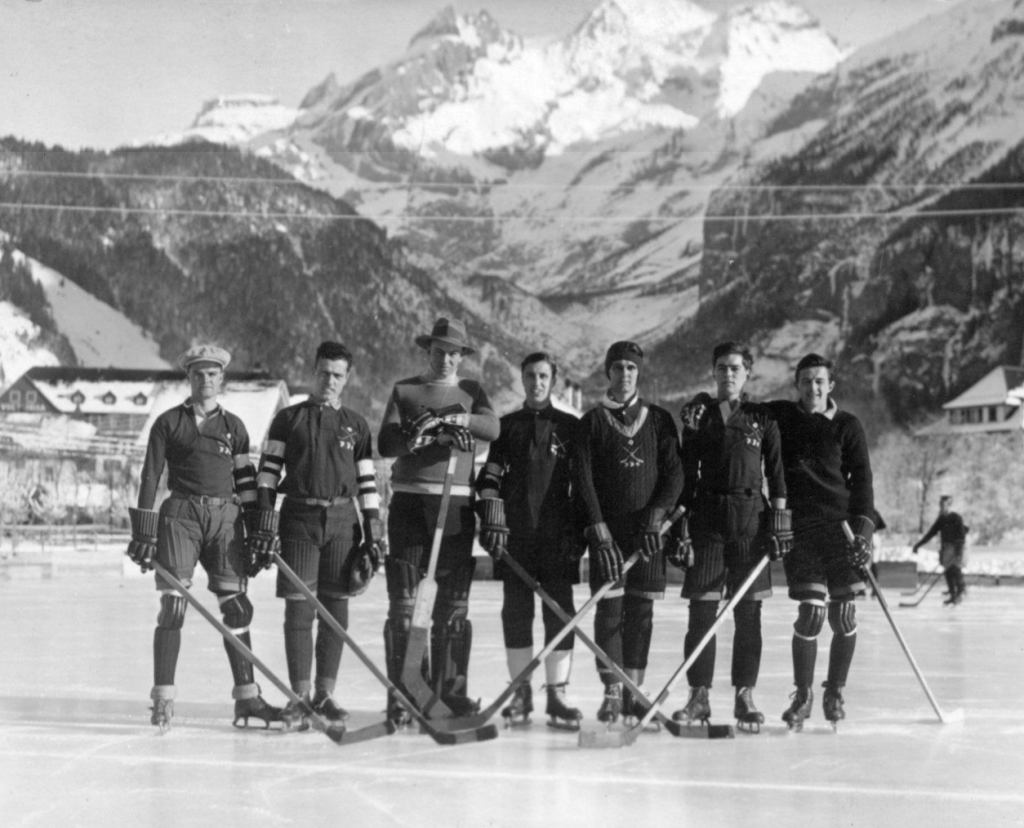
Top: The Oxford men’s 2nd team, the Cosmopolitans, in the village of Kandersteg in Switzerland in 1930. The team would later be revived as the Oxford Vikings in 1994. While not the oldest Oxbridge rivalry, the Oxford Vikings versus Cambridge Eskimos match is about 100 years old, originating in the Swiss Alps.
The OUIHC continued to dominate in European tournaments throughout the 1920s. In 1923, The Guardian newspaper declared that ‘the Oxford University Ice Hockey team […] has earned the reputation of being the best ice hockey team which has yet visited Europe, with the exception of the Canadian and American side which took part in the Olympic Games‘. In 1928, a British sports magazine wrote that, aside from the tours of North American teams, ‘the chief ice hockey event in Europe is the intervarsity match’, and it was ‘[t]hanks to the Rhodes Scholars of Oxford’ that ‘the real game has been known for several years in some of the winter-resorts of Switzerland.’
During the 20s and 30s, Oxford had enough players to form a second team, the Oxford Cosmopolitans, who would play the Cambridge Eskimos in the second string Varsity Match throughout this period.
In 1923, the OUIHC travelled to Davos, Switzerland, to play in the inaugural Spengler Cup tournament (now an international tournament featuring professional players). In their first of 18 Spengler Cup appearances, Oxford beat Berliner Schlittzschuhclub to become the inaugural winners in 1923 (score 7-3), followed by 3 more tournament wins in 1925 (beating HCV Davos, 2-0), 1931 (beating Berliner SC again, 4-1), and 1932 (shared with LTC Prague after a tied game), and a second place finish in 1934 (losing to Diavoli Rossoneri Milano, 0-2).
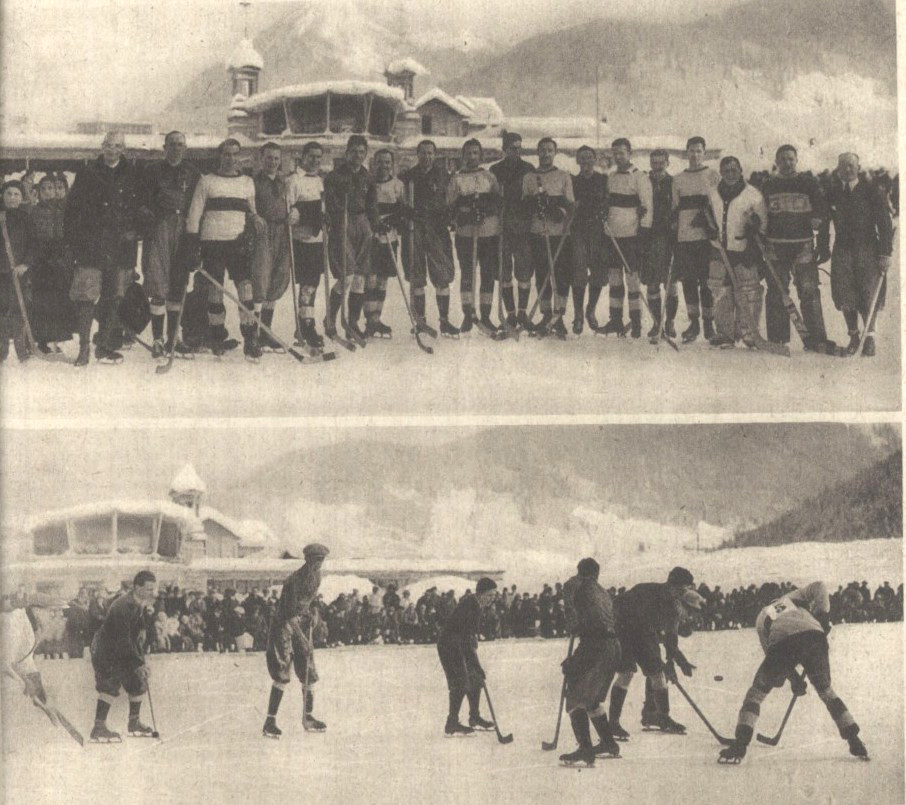
Oxford versus Wiener EV (Vienna) in the inaugural Spengler Cup in 1923. (score: 3-0).
Footage of OUIHC versus LTC Prague in the final of the 1932-33 Spengler Cup held in Davos, Switzerland. (score: 0-0 despite overtime).
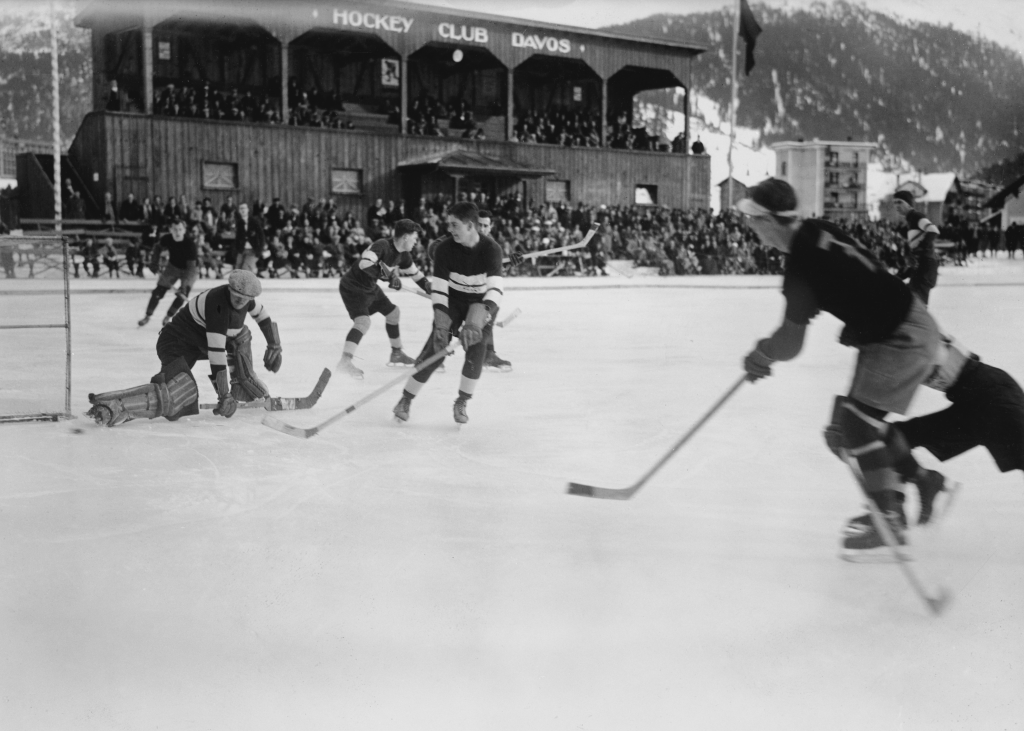
OUIHC versus the Czech National team in the 1931 Eurorpean Championships in Davos Switzerland (Oxford in Blue and white).
In addition to the European tournaments, the 1920s and 30s saw the OUIHC host a number of other National teams including Belgium, France, Germany and Canada, and a number of touring Canadian teams including the Edmonton Superiors and the Ottawa Shamrocks. This era also saw the OUIHC hosted regularly by Lyceum Alpinum Zuoz, a Swiss international boarding school near St. Moritz, who recently revived this century old tradition by hosting the Men’s Blues Varsity Match in 2018 and their annual winter training camp since then.
After the success of the 1920s and 30s, the mayor of Oxford presented the OUIHC players with gold medals in recognition of their success and skill on the ice. Consequently, in 1933, after petitioning from the Blues Captain Charles Little, the OUIHC received Blues Status from the University and nine Oxford players received the first Oxford Blues for ice hockey after defeating Cambridge 1-0. Since this date, with the exception of the brief loss of Blues Status between 2013 and 2014, the most skilled OUIHC players who have competed in the Varsity Match have received Oxford Blues.
The rules of the Varsity Match are implemented by the Joint Blues Committees of Oxford and Cambridge to ensure the quality and integrity of the match is retained with only matriculated Oxford and Cambridge students participating.
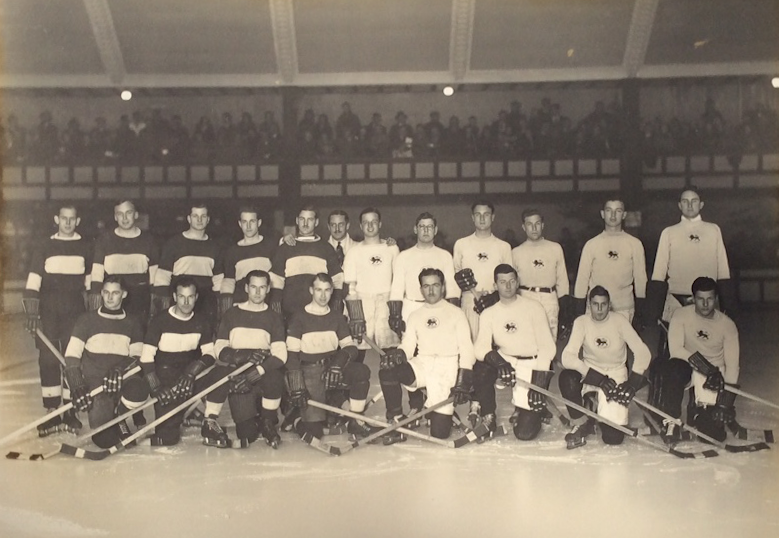
Oxford (left) and Cambridge (right) after the 1933 Varsity Match (1-0 win) in which the inaugural Oxford Blues were awarded.
With peace declared in Europe, the OUIHC returned under the leadership of two Canadian Rhodes Scholars and WWII veterans, John Coyne and Gordan Blair. Many Oxford players who joined in the post-war years had previously military experience with many serving in the Royal Air Force. Close ties between OUIHC and the RAF exist to this day with the annual OUIHC versus RAF Charity Match which raises funds and awareness for the charity partners of both respective organisations.
OUIHC and the annual Varsity Match continued throughout the 50, 60s, and 70s with a number of notable alumni icing for Oxford, including Heisman Trophy winner and American Football star, Peter Dawkins in 1960 (featured in the video).
The 1960 Varsity Match
The establishment of a Women’s Blues team within OUIHC was a relatively late creation. This was due to the fact that only a small number of women’s colleges existed and that many of the other colleges did not become co-educational until the 1980s. Furthermore, the Rhodes scholarship (among other scholarships) was not offered to women until 1977, which inadvertently kept the number North American women low. From the 1980s, a steady influx of women to the university supported the formation of the Oxford Women’s Blues ice hockey team.
Right: The 1981-82 Oxford and Cambridge Women’s Blues teams after their inaugural Varsity Match in 1982
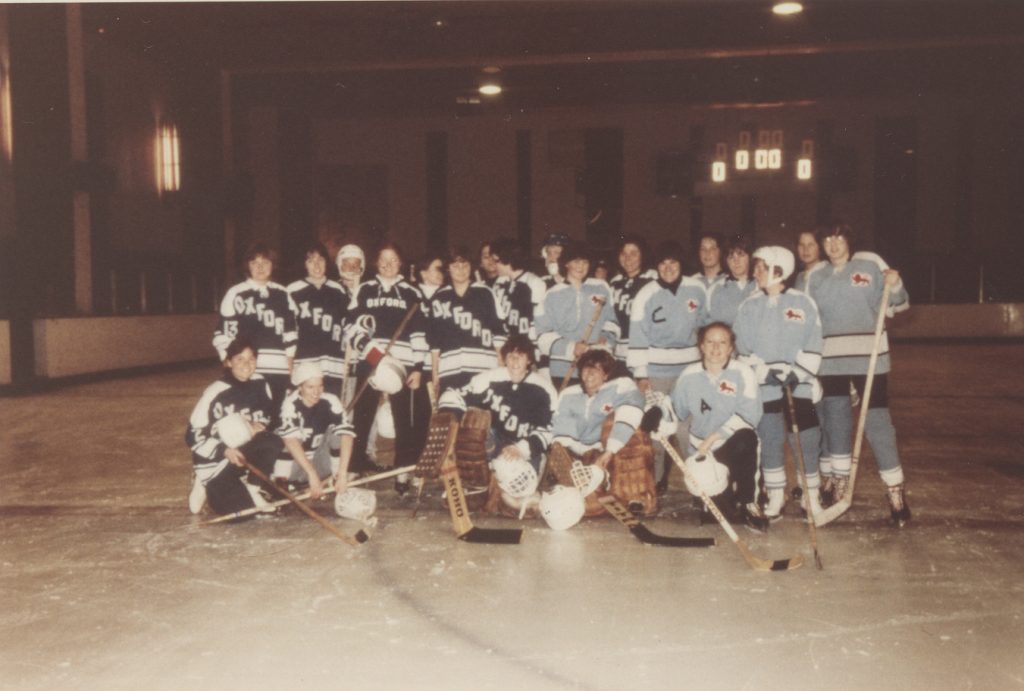

The 1985 Oxford and Cambridge Women’s Blues
It was a Canadian who would establish women’s ice hockey at Oxford. In 1981, a commonwealth scholar at Wadham college, Deborah Coyne, founded the OUWIHC. Coyne contacted several women’s teams across the UK and formed the first British women’s ice hockey league. That same year she persuaded the Cambridge University Ice Hockey Club to form a women’s team and in the spring of 1982, the inaugural women’s Varsity Match was played. Despite the match going ahead, Cambridge was without a goalie and so the starting goalie for Oxford would step between the pipes for the Cambridge Light Blues, ironically stealing them a 3-1 win. In spite of the loss, the founder of OUWIHC and the Women’s Varsity Match potted the lone Oxford goal in this opening fixture.
The Women’s Varsity Match is the oldest all-women’s ice hockey rivalry in the world. Nowadays, the fixture is played alongside the men’s games on Varsity Match weekend in March in front of crowds, with the Women’s Blues teams competing for the Coyne Cup. Both women’s teams have been a driving force for women’s university ice hockey through their existence and now a growing number of women’s teams exist in the British Universities Ice Hockey Association (BUIHA). In 2017, the Oxford Women’s Blues won the inaugural BUIHA Women’s National Championships which featured six women’s university teams.

The 2014 Women’s Varsity Match played in front of a full Oxford arena. The Oxford Dark Blues won the match and were handed the trophy by Dark Blue alumna, Dianna Carney (née Fox), who played for the Blues in 1995.
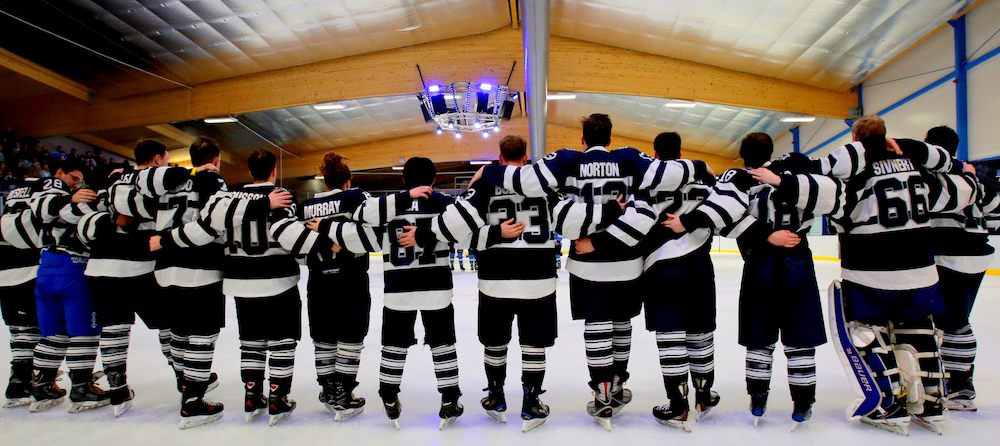
Since 1885, the Oxford University Ice Hockey Club (OUIHC) has been the highlight of many students’ time in the city of dreaming spires. Many of us fondly remember cycling to the rink, the locker-room chat, and travelling to away games in the corners of the UK and Europe. During our Oxford days, the Club was our home away from home.
‘He loved the game… we all did – and that’s why it survived’
⎯ Colin Brezicki, Oxford Captain 1971 (talking about that year’s goalie – a South African cricket wicket keeper turned hockey goalie who had to be carried across the ice between periods)
We are proud of our Club’s heritage, and to this day OUIHC continues to be an exemplary all-inclusive student-run organisation that welcomes all players irrespective of ability. The OUIHC remains one of the last bastions of true amateur, university hockey worldwide and one of the top amateur clubs in the UK. Every year we take to the ice to write the next chapter in hockey’s oldest rivalry.
